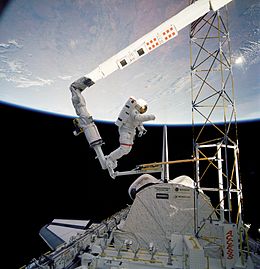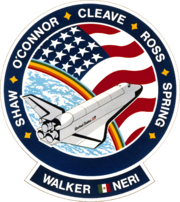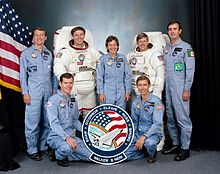
Back STS-61-B Arabic STS-61B Bulgarian STS-61-B Czech STS-61-B Danish STS-61-B German STS-61-B Spanish استیاس-۶۱-بی Persian STS-61-B Finnish STS-61-B French STS-61-B Galician
 Construction of the ACCESS structure. | |
| Names | Space Transportation System-23 |
|---|---|
| Mission type | Satellites deployment Technology |
| Operator | NASA |
| COSPAR ID | 1985-109A |
| SATCAT no. | 16273 |
| Mission duration | 6 days, 21 hours, 4 minutes, 49 seconds |
| Distance travelled | 3,970,181 km (2,466,956 mi) |
| Orbits completed | 109 |
| Spacecraft properties | |
| Spacecraft | Space Shuttle Atlantis |
| Launch mass | 118,664 kg (261,609 lb) |
| Landing mass | 93,316 kg (205,727 lb) |
| Payload mass | 21,791 kg (48,041 lb) |
| Crew | |
| Crew size | 7 |
| Members | |
| EVAs | 2 |
| EVA duration |
|
| Start of mission | |
| Launch date | November 27, 1985, 00:29:00 UTC (7:29 pm EST) |
| Launch site | Kennedy, LC-39A |
| Contractor | Rockwell International |
| End of mission | |
| Landing date | December 3, 1985, 21:33:49 UTC (1:33:49 pm PST) |
| Landing site | Edwards, Runway 22 |
| Orbital parameters | |
| Reference system | Geocentric orbit |
| Regime | Low Earth orbit |
| Perigee altitude | 361 km (224 mi) |
| Apogee altitude | 370 km (230 mi) |
| Inclination | 28.45° |
| Period | 91.90 minutes |
| Instruments | |
| |
 STS-61-B mission patch  Back row: Walker, Ross, Cleave, Spring and Neri Vela Front row: O'Connor and Shaw | |
STS-61-B was the 23rd NASA Space Shuttle mission, and its second using Space Shuttle Atlantis. The shuttle was launched from Kennedy Space Center, Florida, on November 26, 1985. During STS-61-B, the shuttle crew deployed three communications satellites, and tested techniques of constructing structures in orbit. Atlantis landed at Edwards Air Force Base, California, at 16:33:49 EST on December 3, 1985, after 6 days, 21 hours, 4 minutes, and 49 seconds in orbit.
STS-61-B marked the quickest turnaround of a Shuttle orbiter from launch to launch in history – just 54 days elapsed between Atlantis' launch on STS-51-J and launch on STS-61-B. As of August 2022[update], this is still the record for turn around between two flights of the same orbital space vehicle. The mission was also notable for carrying the first Mexican astronaut, Rodolfo Neri Vela. This was also Atlantis' second and final mission before the Space Shuttle Challenger disaster in 1986. The Challenger disaster would ground the shuttle fleet for two and a half years and Atlantis would not fly again until STS-27, which launched three years later on December 2, 1988.